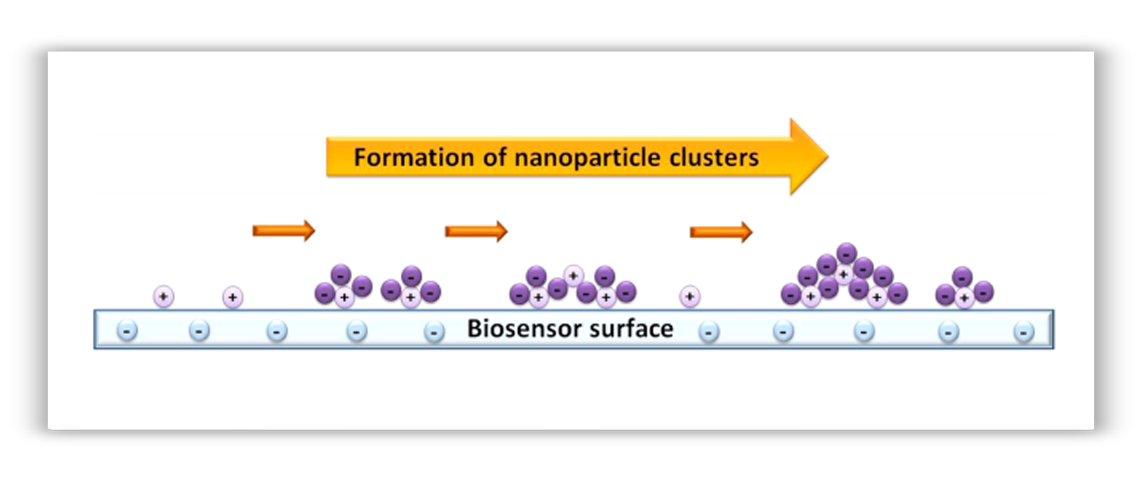Our laboratory has much experience in the production of polymers to influence cellular adhesion, for example dextran, PLL-g-PEG polymer and nanoparticle coatings on biosensor surfaces. We apply flagellin based biomimetic coatings as well to alter the adhesivity of the cells.
Collaboration partners: University of Pannonia, Budapest University of Technology and Economics.

Representative AFM image of titanate nanotube (TNT) coating on OWLS chip.

Schematic illustration of nanoparticle cluster buildup from oppositely charged nanoparticles on OWLS chip.

nA–adsorbed mass curves recorded from carboxymetilated dextran (CMD) grafting experiments at different conditions.
A: aminosilylated, E: epoxysilylated surfaces (by the arrows, G refers to the grafting, W to the washing phase).
The change in the structure of the CMD layer on the surface is schematically drawn.
A: aminosilylated, E: epoxysilylated surfaces (by the arrows, G refers to the grafting, W to the washing phase).
The change in the structure of the CMD layer on the surface is schematically drawn.

Preparation of flagellin-based molecular coatings. Flagellar filaments are removed from the bodies
of bacteria by vortexing and purified in several centrifugation steps. Next, filaments are heat-treated
to obtain monomer flagellin units. On the hydrophobic surface flagellins form an oriented
of bacteria by vortexing and purified in several centrifugation steps. Next, filaments are heat-treated
to obtain monomer flagellin units. On the hydrophobic surface flagellins form an oriented
monolayer.(a) Wild-type flagellin. (b) RGD (Arginylglycylaspartic acid) displaying
flagellin variants. The displayed peptide sequences are also shown.

flagellin variants. The displayed peptide sequences are also shown.

Schematic representation of the Poly(allylamine) hydrochloride (PAH)–monomeric flagellin composite film buildup.
The inset shows a filament starting PAH induced flagellin nucleation and subsequent polymerization.
The inset shows a filament starting PAH induced flagellin nucleation and subsequent polymerization.
Relevant publications:
Nador et al. Enhanced protein adsorption and cellular adhesion using transparent titanate nanotube thin films made by a simple and inexpensive room temperature process: Application to optical biochips. Colloids and Surfaces B: Biointerfaces, 2014
Peter et al. Label-Free in Situ Optical Monitoring of the Adsorption of Oppositely Charged Metal Nanoparticles. Langmiur, 2015
Peter et al. Label-Free in Situ Optical Monitoring of the Adsorption of Oppositely Charged Metal Nanoparticles. Langmiur, 2015
Saftics et al. Fabrication and characterization of ultrathin dextran layers: Time dependent nanostructure in aqueous environments revealed by OWLS. Colloids and Surfaces B: Biointerfaces, 2016
Kovacs et al. Flagellin based biomimetic coatings: From cell-repellent surfaces to highly adhesive coatings. Acta Biomaterialia, 2016
Farkas et al. Self-assembly and structure of flagellin–polyelectrolyte composite layers: polyelectrolyte induced flagellar filament formation during the alternating deposition process. RSC Advances, 2016
Kovacs et al. Flagellin based biomimetic coatings: From cell-repellent surfaces to highly adhesive coatings. Acta Biomaterialia, 2016
Farkas et al. Self-assembly and structure of flagellin–polyelectrolyte composite layers: polyelectrolyte induced flagellar filament formation during the alternating deposition process. RSC Advances, 2016

